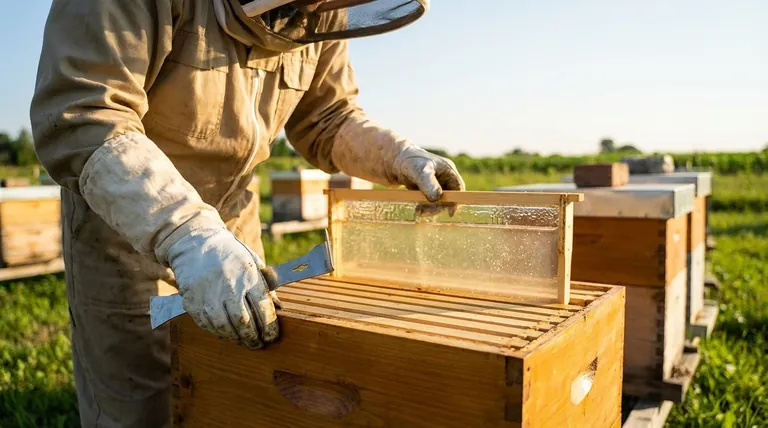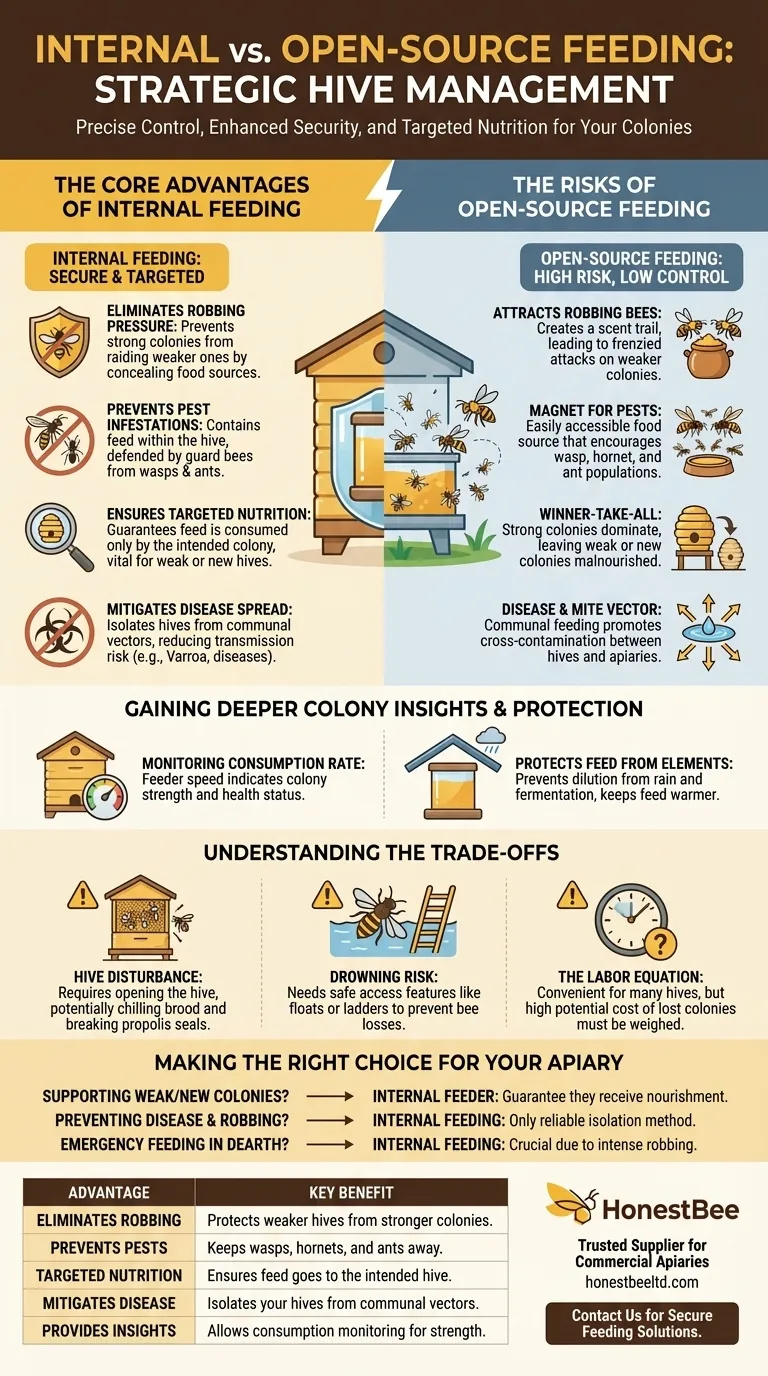The primary advantage of internal feeding is that it gives you precise control over which colonies receive nourishment while protecting them from external threats like robbing and disease. This method ensures your intended hives, especially weaker ones, get the full benefit of the feed without attracting unwanted competition from neighboring bees or pests.
Choosing a feeding method isn't just about providing food; it's a strategic decision that directly impacts hive security and health. Internal feeding prioritizes protection and precision, while open feeding prioritizes convenience at the cost of significant risk.

The Core Benefits of Feeding Inside the Hive
When you feed bees, your goal is to support a specific colony. Internal feeding ensures that support goes exactly where it's intended, acting as a secure and targeted nutritional strategy.
Eliminating Robbing Pressure
By keeping the food source (syrup or fondant) inside the hive, you eliminate the scent trail that attracts bees from other colonies. This is the single most effective way to prevent robbing, a frenzied attack where stronger colonies raid weaker ones for their stores, often resulting in the collapse of the weaker hive.
Preventing Pest Infestations
Open food sources are a magnet for pests like wasps, hornets, and ants. Internal feeders contain the food within the confines of the hive, where the colony's guard bees can effectively manage access and prevent these pests from establishing a foothold.
Ensuring Targeted Nutrition
Open feeding is a free-for-all. Strong, populous colonies will dominate the food source, while weak or new colonies that need the nourishment most will be outcompeted and may get nothing at all. Internal feeding guarantees that the feed you provide is consumed only by the hive you are trying to help.
Mitigating Disease Spread
An open feeder acts as a communal watering hole for bees from every hive in the area, including feral colonies or those from other apiaries. This creates a perfect vector for transmitting diseases and mites (like Varroa) from one colony to the next. Internal feeding isolates your hives from this risk.
Gaining Deeper Colony Insights
Beyond security, internal feeding provides valuable data about the health and status of your colony.
Monitoring Consumption Rate
The speed at which a colony consumes its internal feed is a direct indicator of its strength and population. A strong hive will empty a feeder quickly, while a slow consumption rate in a populous hive could signal a problem that requires further inspection.
Protecting Feed from the Elements
Internal feeders protect the sugar syrup from rain, which can dilute it and render it useless or even cause it to ferment. The feed is also kept warmer by the hive's ambient temperature, making it easier for bees to consume during cooler weather.
Understanding the Trade-offs
No method is without its downsides. Understanding the trade-offs is key to making an informed decision.
The Risk of Hive Disturbance
The primary drawback of internal feeding is that it requires you to open the hive to check and refill the feeder. This disturbs the colony, breaks the propolis seal, and can chill the brood, especially in cold weather.
The Danger of Drowning
Some internal feeders, particularly frame feeders, can pose a drowning risk to bees. It is critical to use models that include floats, ladders, or textured inner walls to ensure bees have a safe way to access the syrup.
The "Winner-Take-All" Problem of Open Feeding
The main appeal of open feeding is convenience, but this convenience comes at a high cost. It disproportionately benefits the strongest hives and puts your weakest hives at extreme risk of being robbed out of existence.
The Labor Equation
For a beekeeper with many hives, setting up one large open feeder is faster than refilling dozens of internal feeders. However, this saved time must be weighed against the potential cost of losing entire colonies to robbing or disease.
Making the Right Choice for Your Apiary
Your feeding strategy should be a conscious choice based on your specific goals and the condition of your hives.
- If your primary focus is supporting a weak or new colony: Choose an internal feeder to guarantee they receive the food without having to fight for it.
- If your primary focus is preventing disease and robbing: Internal feeding is the only reliable method to isolate your hives from these external threats.
- If your primary focus is emergency feeding during a nectar dearth: Internal feeding is crucial, as a dearth is when robbing behavior is most intense.
Ultimately, tailoring your feeding strategy to the specific needs of your colonies is the hallmark of a proactive and successful beekeeper.
Summary Table:
| Advantage | Key Benefit |
|---|---|
| Eliminates Robbing | Protects weaker hives from stronger colonies raiding their food. |
| Prevents Pest Infestations | Keeps wasps, hornets, and ants away from the food source. |
| Targeted Nutrition | Ensures the feed goes to the specific hive you intend to support. |
| Mitigates Disease Spread | Isolates your hives from communal disease vectors. |
| Provides Health Insights | Allows monitoring of consumption rates to gauge colony strength. |
Ready to implement a secure feeding strategy for your apiary?
As a trusted supplier for commercial apiaries and beekeeping equipment distributors, HONESTBEE provides the durable, reliable internal feeders and equipment you need to protect your investment and promote colony health. Our wholesale-focused operations ensure you get the right tools for proactive hive management.
Contact our team today to discuss your needs and explore our range of beekeeping supplies.
Visual Guide

Related Products
- HONESTBEE Advanced Ergonomic Stainless Steel Hive Tool for Beekeeping
- Professional Dual-End Stainless Steel Hive Tool for Beekeeping
- Professional 3-Bar Frame Grip with Integrated Hive Tool
- Yellow Plastic Bucket Pail Perch for Beekeeping
- Beehive Handle and Frame Rest Cutting Machine: Your Specialized Hive Machine
People Also Ask
- What is the hole in a hive tool for? A Multi-Tool for Apiary Repairs and Maintenance
- What are the features of a regular hive tool? The Essential Multi-Tool for Every Beekeeper
- Why do hive tools have a hole? Unlock the Secret to Efficient Beekeeping
- What are the basic tools for beekeeping? Essential Starter Kit for Safe & Successful Hive Management
- What tools are used for cleaning frames? A Beekeeper's Simple 4-Tool Guide



















